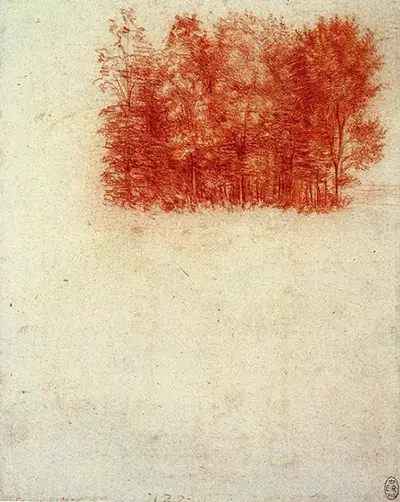It is a nature study centred on mixed woodland of incredible clarity for chalk, further illustrating the diverse talent of the artist.
Da Vinci had a large array of interests which were displayed in his paintings and drawings, offering up a unique insight in to the way he viewed the world around him and how he tried to understand and explain it.
In the Birch Copse the softness of the red chalk aids in reproducing light and shade in the subject, helping to show the clarity of the leaves and boughs.
The Notebooks of Da Vinci
The format of the page along with the positioning of the drawing indicates that The Birch Copse was originally from of one of da Vinci's notebooks.
Da Vinci had a huge interest in many subjects including botany and his notes and drawings were often on loose sheets of paper kept in notebooks.
On his death in 1519 near Amboise in France, these notebooks were left to his assistant, Francesco Melzi, who took them back to Milan.
These notebooks formed a large basis of the Trattato Della Pittura produced by Melzi to record Leonardo da Vinci's thoughts and notions on painting. It is uncertain whether the drawing of the Birch Copse was ever used in a painting by da Vinci, although there are similar representations from his followers in Milan.
Disciple of Nature
Leonardo Da Vinci's approach to his many interests including botany went beyond just the observational. Da Vinci went in to extraordinary detail in his pursuit to understand the way things worked and this extended to the laws of nature. His notebooks between 1498 and 1502 contained similar groups of tree drawings to the Birch Corpse, an interest that only increased.
Studies in Brambles produced around 1505 to 1510, shows the same use of red chalk on paper as the Birch Copse to produce the same careful attention to detail. Da Vinci observed in his study of trees an almost universal pattern in a tree's growth between the size of the trunk and its branches.
The Birch Copse is another example of Leonardo da Vinci's ability to observe and portray with extraordinarily clarity the world he saw around him.
His desire to understand the way things worked was strong and this gathered knowledge was illustrated in his art. His notebooks show he had many areas of interest of which botany and nature was one.
Book 6 of his Libro di Pittura was dedicated to the subject and Da Vinci created many drawings of trees and plants, branches and stems, of which the Royal Library at Windsor plays host to a number of them.


